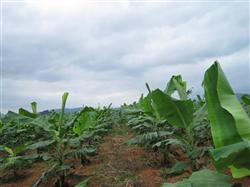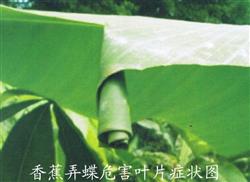How to manage bananas before and after budding?

How to manage bananas before and after budding? Please introduce the management method banana before and after budding management can refer to the following methods: first, timely fertilization. Banana entering the stage of flower bud differentiation is the key period to determine the number of fruit comb and small fruit, and heavy fertilizer should be applied in time. That is, when the opposite leaves were extracted from the banana leaves, each plant was applied with 30kg of soil miscellaneous fertilizer, 3kg of manure, 0.3kg of peanut bran or 0.2kg of compound fertilizer, spread evenly on the border after light soil, and returned to thin soil after application. Before budding, banana pre-anthesis fertilizer was applied once, each plant applied 50 grams of urea, 50 grams of potassium chloride, or 200 grams of compound fertilizer, or 250 grams of rotten peanut bran. After budding, when the banana bud was broken, 150 grams of compound fertilizer was applied to each plant, combined with farm fertilizer and water. In addition, extra-root topdressing is carried out every 10 to 15 days, which can be sprayed with 1000 times of rare earth foliar fertilizer or 0.2% potassium dihydrogen phosphate to delay premature senescence of leaves and promote the development of young fruits. Second, break the bud in time. Continue to remove unused sucking buds and concentrate nutrients for banana budding. When the fruit bud appears, we should pay attention to check the banana plant, remove the leaves that block the natural sagging of the banana ear, prevent the appearance of abnormal fruit comb or banana leaf scratch the fruit body and affect the appearance. About 10 days after budding, when the banana buds pulled out less than 5 or 8 female flowers in the last comb, the buds were cut off at noon in the next comb. After the bud is broken, when the wound juice of the banana axis stops to overflow, brush the wound with carbendazim or methomyl 400 times to prevent bacterial infection. Third, rational irrigation. Banana bud period of moisture requirements are more stringent, not only requires the soil moist, but also afraid of soil too wet. Pay attention to avoid stagnant water in furrows on rainy days to prevent rotting roots. In case of drought, it is necessary to maintain the shallow water layer of the border ditch to facilitate watering sooner or later to meet the water needs of plants and fruits. In the typhoon-prone season, banana piles should be set up in time, trench mud should be dug to cultivate plants with exposed roots, so as to enhance wind resistance. Fourth, prevention and control of diseases and insect pests. After budding of banana, due to the excessive consumption of nutrients and the weakening of plant disease resistance, the occurrence of leaf spot disease is becoming more and more serious. If the disease is not controlled well, the number of green leaves is less than 8, which will affect the yield and quality of banana fruit. For banana plantations with serious disease, the diseased leaves and withered pseudostems should be cut off in time, and after concentrated burning, fungicides such as 1200 times of enemy force, or 1000 times of biprolol, or 400 times of aldicarb should be sprayed every 15 days for 4 times. In case of rainy days, spray in time to protect the wound. If you find the harm of butterflies and aphids, use the enemy to kill, kill Surey and other insecticides. Click to get more banana planting techniques click to get more fruit planting techniques
- Prev

How to fertilize bananas?
How to fertilize bananas? Please give guidance on fertilization methods Banana planting can refer to the following methods for fertilization: (1) Drenching fertilizer or retting bran fertilizer, manure water or EM biological fertilizer diluted with water, drenching at the roots of the plant. (2)To perforate, dig, or furrow the ground around a pseudostem to place fertilizer (including...
- Next

What are the diseases and insect pests of growing bananas?
What are the diseases and insect pests of growing bananas? Please give an introduction to the following diseases and insect pests: disease control 1, bunchy top disease and mosaic heart rot. All of them are caused by virus and there is no specific cure. Aphids are the main media of infection and should be prevented in time. The effect of adding plant growth regulator to the insecticide solution is better. ...
Related
- Moge, come on! The staff of the peasant association in the producing area of cantaloupe were frightened when the crowd gathered.
- Causes and Solutions of low Fruit setting rate of Apple
- Symptoms and control measures of passion fruit virus disease
- Fruit growing lesson: how do apple orchards keep high yields?
- Can you build orchards in the mountains? What are the pros and cons?
- How to manage the coloring period of Crisson grape?
- This paper introduces the processing technology of two kinds of fig products.
- How much is a month for retired teachers in rural areas by 2020?
- How can strawberry planting increase sugar content? We should pay attention to management in many aspects.
- What are the cultivation techniques on how to improve the yield of golden fruit?

